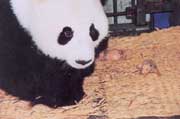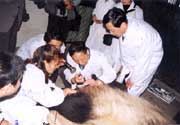|
 The manual breeding of giant pandas began about 4000 years ago, but the artificial reproduction of giant panda did not succeed till 1963 when LiLi and SenSen mated under natural circumstances and gave birth to a panda cub. In 1978, artificial fertilization successfully led to the birth of a panda cub. In 1980, artificial fertilization with refrigerated sperm also succeeded in Chengdu Zoo. With manual breeding, the possibility of natural mating was quite low because the ovulation period of a female panda only lasts for one to three days although it may be in heat for a much longer period. In order to ensure a relatively high pregnancy ratio, the current method usually applies high technologies to define the ovulation period and uses repeated artificial fertilization.The first foreign institute that succeeded in artificial reproduction of giant panda is Keisei Ueno Zoo of Japan who successfully delivered a panda cub in 1979. In recent years, the breeding of panda cubs have also achieved great progress. In 1990, Chengdu Zoo led the way by raising a pair of twin panda cubs with manual breeding; in 1992, Beijing Zoo tackled the problem of low survival rate of the young panda cubs that have not been fed by the panda mother. The manual breeding of giant pandas began about 4000 years ago, but the artificial reproduction of giant panda did not succeed till 1963 when LiLi and SenSen mated under natural circumstances and gave birth to a panda cub. In 1978, artificial fertilization successfully led to the birth of a panda cub. In 1980, artificial fertilization with refrigerated sperm also succeeded in Chengdu Zoo. With manual breeding, the possibility of natural mating was quite low because the ovulation period of a female panda only lasts for one to three days although it may be in heat for a much longer period. In order to ensure a relatively high pregnancy ratio, the current method usually applies high technologies to define the ovulation period and uses repeated artificial fertilization.The first foreign institute that succeeded in artificial reproduction of giant panda is Keisei Ueno Zoo of Japan who successfully delivered a panda cub in 1979. In recent years, the breeding of panda cubs have also achieved great progress. In 1990, Chengdu Zoo led the way by raising a pair of twin panda cubs with manual breeding; in 1992, Beijing Zoo tackled the problem of low survival rate of the young panda cubs that have not been fed by the panda mother.
 |
 |
Current Situation of Breeding Pandas
A miracle of Artificial Reproduction- MeiMei
|